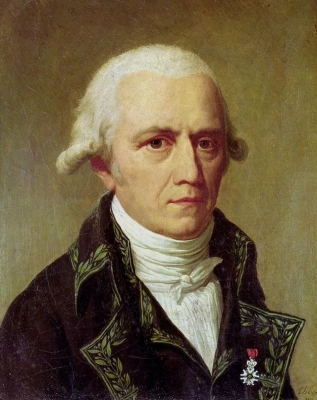
Jean Baptiste Lamarck (1744-1829) is one of the best-known early evolutionists. Unlike Darwin, Lamarck believed that living things evolved in a continuously upward direction, from dead matter, through simple to more complex forms, toward human “perfection.” Species didn’t die out in extinctions, Lamarck claimed. Instead, they changed into other species. Since simple organisms exist alongside complex “advanced” animals today, Lamarck thought they must be continually created by spontaneous generation.
Lamarck was the youngest of 11 children in a family of the lesser nobility. His family intended him for the priesthood, but, after the death of his father and the expulsion of the Jesuits from France, Lamarck embarked on a military career in 1761. As a soldier garrisoned in the south of France, he became interested in collecting plants. An injury forced him to resign in 1768, but his fascination for botany endured, and it was as a botanist that he first built his scientific reputation.
Lamarck gained attention among the naturalists in Paris at the Jardin et Cabinet du Roi (the king’s garden and natural history collection, known informally as the Jardin du Roi) by claiming he could create a system for identifying the plants of France that would be more efficient than any system currently in existence, including that of the great Swedish naturalist Carolus Linnaeus. This project appealed to Georges-Louis Leclerc, comte de Buffon, who was the director of the Jardin du Roi and Linnaeus’s greatest rival. Buffon arranged to have Lamarck’s work published at government expense, and Lamarck received the proceeds from the sales. The work appeared in three volumes under the title Flore française (1778; “French Flora”). Lamarck designed the Flore française specifically for the task of plant identification and used dichotomous keys, which are classification tools that allow the user to choose between opposing pairs of morphological characters (see taxonomy: The objectives of biological classification) to achieve this end.
With Buffon’s support, Lamarck was elected to the Academy of Sciences in 1779. Two years later Buffon named Lamarck “correspondent” of the Jardin du Roi, evidently to give Lamarck additional status while he escorted Buffon’s son on a scientific tour of Europe. This provided Lamarck with his first official connection, albeit an unsalaried one, with the Jardin du Roi. Shortly after Buffon’s death in 1788, his successor, Flahault de la Billarderie, created a salaried position for Lamarck with the title of “botanist of the King and keeper of the King’s herbaria.”
Between 1783 and 1792 Lamarck published three large botanical volumes for the Encyclopédie méthodique (“Methodical Encyclopaedia”), a massive publishing enterprise begun by French publisher Charles-Joseph Panckoucke in the late 18th century. Lamarck also published botanical papers in the Mémoires of the Academy of Sciences. In 1792 he cofounded and coedited a short-lived journal of natural history, the Journal d’histoire naturelle.
Credit : Britannica
Picture Credit : Google




